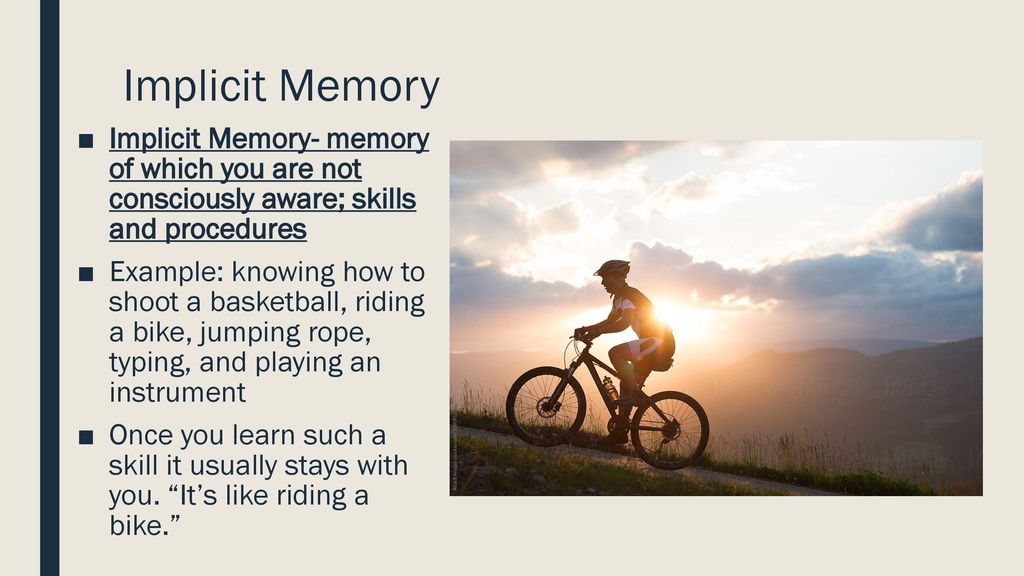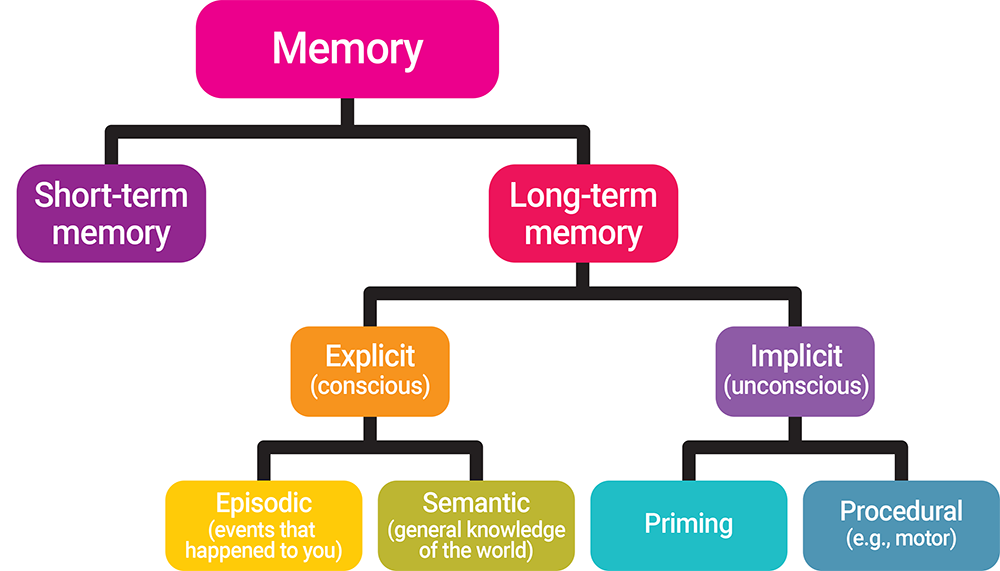What Type Of Memory Is Not Consciously Accessible To Us

The human brain, a universe of intricate connections and boundless capacity, holds memories of all kinds. Some memories, like the recollection of a childhood birthday or the name of a close friend, are readily available, surfacing with ease into our conscious awareness. However, a vast landscape of memory operates beneath the surface, shaping our actions, preferences, and even our fears, often without our explicit knowledge.
This article delves into the realm of memory that remains outside of conscious access. We will explore the fascinating world of implicit memory, also known as nondeclarative memory, examining its various forms, its impact on our lives, and what makes it so different from the consciously accessible explicit memory. Unraveling this hidden dimension of memory offers valuable insights into how we learn, adapt, and navigate the world around us.
Understanding Implicit Memory: Beyond Conscious Recall
Implicit memory is a type of long-term memory that doesn't require conscious thought. It's expressed through performance rather than recollection.
This is in contrast to explicit memory (also known as declarative memory), which involves the conscious recollection of facts and events. While you can readily state your phone number (explicit memory), you likely can't consciously describe the steps involved in riding a bicycle (implicit memory).
Types of Implicit Memory
Implicit memory encompasses several different types, each involving distinct brain regions and underlying processes. Understanding these subtypes is key to appreciating the breadth of implicit memory's influence.
Procedural Memory
Perhaps the most well-known form of implicit memory, procedural memory involves learning skills and habits. These skills become automatic over time, requiring little conscious effort.
Examples include riding a bike, typing on a keyboard, playing a musical instrument, or even brushing your teeth. The basal ganglia and cerebellum play crucial roles in procedural memory.
Priming
Priming refers to the enhanced identification of objects or words as a result of prior exposure. This exposure influences subsequent responses without conscious awareness.
For example, if you are shown the word "doctor" and then asked to quickly complete the word fragment "n_r_e", you are more likely to say "nurse" than if you hadn't seen the word "doctor". Priming primarily relies on the neocortex.
Classical Conditioning
Classical conditioning, famously demonstrated by Pavlov's experiments with dogs, involves learning associations between stimuli. A neutral stimulus becomes associated with a meaningful one, eliciting a conditioned response.
For instance, associating a particular song with a positive experience can lead to feelings of joy every time you hear that song, even years later. The amygdala is crucial for emotional conditioning.
Nonassociative Learning
Nonassociative learning involves changes in behavior after repeated exposure to a single stimulus. Habituation, a decrease in response to a repeated stimulus, and sensitization, an increase in response after a strong stimulus, fall under this category.
For example, you might initially be startled by a loud noise, but eventually, you'll get used to it and no longer react. These processes involve various neural pathways depending on the stimulus and response.
The Neurological Basis of Implicit Memory
While explicit memory relies heavily on the hippocampus, implicit memory engages different brain structures depending on the type of memory involved. Damage to the hippocampus often impairs explicit memory, leaving implicit memory largely intact, a key piece of evidence distinguishing the two systems.
The basal ganglia, cerebellum, amygdala, and neocortex all play critical roles in different forms of implicit memory. This distributed network allows for the efficient and unconscious learning of skills, associations, and habits.
The Impact of Implicit Memory on Everyday Life
The influence of implicit memory is pervasive, shaping our behaviors and perceptions in countless ways. From the ease with which we perform familiar tasks to the subtle biases that influence our judgments, implicit memory plays a critical role.
It allows us to navigate our environment efficiently, freeing up conscious resources for more complex tasks.
"Implicit biases, often rooted in implicit memory, can lead to unintentional discrimination in various contexts, from hiring decisions to medical diagnoses.", according to a study published in the *Journal of Personality and Social Psychology*.
Implications for Learning and Rehabilitation
Understanding implicit memory has important implications for education, therapy, and rehabilitation. Recognizing the different pathways for implicit and explicit learning can inform instructional strategies.
For individuals with memory impairments, leveraging implicit memory can be a powerful tool for relearning skills and improving quality of life. For example, individuals with amnesia may not consciously remember practicing a task, but they can still improve their performance through repeated practice, demonstrating the power of procedural memory.
Furthermore, techniques like errorless learning, which minimizes errors during the learning process, can effectively tap into implicit memory to facilitate skill acquisition in individuals with cognitive impairments.
Future Directions in Implicit Memory Research
Research on implicit memory continues to evolve, exploring the intricate mechanisms and far-reaching consequences of this hidden dimension of memory. Scientists are actively investigating the interplay between implicit and explicit memory systems, seeking to understand how they interact and influence each other.
New technologies, such as neuroimaging techniques, are providing unprecedented insights into the neural underpinnings of implicit memory. These advances promise to further refine our understanding of how implicit memory works and how it can be harnessed for therapeutic and educational purposes.
Future research could also focus on the development of interventions aimed at mitigating the negative consequences of implicit biases. By gaining a deeper understanding of how these biases are formed and maintained, we can develop strategies to promote more equitable and just outcomes in various aspects of life.






+occurs+when.jpg)











